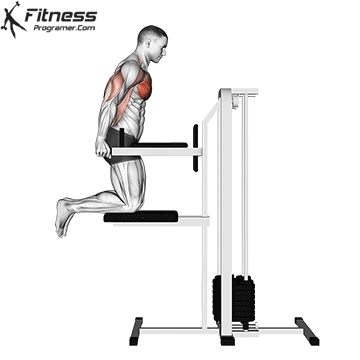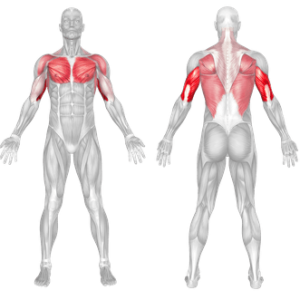Assisted Chest Dip Overview
The Assisted Chest Dip is an easier version designed for individuals who lack the strength to perform unassisted dips. By utilizing assistance from a machine, resistance bands, or a partner, this exercise helps you develop the necessary strength, stability, and proper form to progress towards unassisted dips. It primarily targets the lower chest while also engaging the triceps, shoulders, and core muscles.
How to Perform an Assisted Chest Dip

Using an Assisted Dip Machine
- Set the Resistance: Adjust the machine’s counterweight to an appropriate level. A higher weight provides more assistance, making the exercise easier.
- Position Yourself: Place your knees or feet on the assistance platform, and grip the handles firmly with your palms facing inward or slightly forward.
- Lean Forward: To emphasize the chest, slightly lean your torso forward, keeping your shoulders down and elbows slightly flared (at about a 45-degree angle).
- Lower Your Body: Slowly bend your elbows to lower your body until your upper arms are parallel to the floor or slightly below.
- Press Up: Push yourself back up to the starting position, focusing on engaging your chest and triceps.
- Repeat: Perform the desired number of repetitions with control.
Tips for Effectiveness
- Progress Gradually: Gradually decrease the level of assistance over time to build strength and work toward unassisted dips.
- Focus on Form: Keep your core tight, shoulders down, and chest engaged throughout the movement.
- Breathing: Exhale as you press up and inhale as you lower your body.
- Stretch and Warm-Up: Warm up your shoulders, chest, and triceps before performing dips to prevent strain or injury.
Common Mistakes to Avoid
- Insufficient Forward Lean: Keeping the torso too upright shifts the focus to the triceps rather than the chest.
- Flared Elbows: Excessively flared elbows can increase strain on the shoulders. Keep them at a 45-degree angle.
- Rushed Movement: Performing dips too quickly reduces muscle engagement and increases the risk of injury. Use slow, controlled motions.
- Improper Resistance Setting: Using too much or too little assistance can compromise form. Choose a level that challenges you but allows proper technique.
Benefits of Assisted Chest Dips
- Chest Development: Targets the lower chest, helping to develop strength and size in this region for a more balanced and defined chest.
- Triceps Strength: Improves triceps activation, making it an excellent exercise for arm development.
- Progressive Strength Building: The assisted version allows beginners or those recovering from injury to build the necessary strength and control to perform unassisted dips.
- Improved Form: The assistance reduces the load, enabling better focus on form and muscle engagement.
- Joint-Friendly: Assistance reduces strain on the shoulders, elbows, and wrists, making the exercise more accessible for individuals with joint concerns.
- Core Activation: Helps develop core stability, as the body must remain steady throughout the movement.
Assisted Chest Dip Muscles Worked

